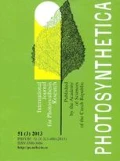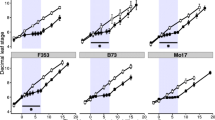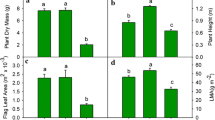Abstract
We tested the usefulness of chlorophyll a fluorescence quenching analysis for the selection of maize parental inbred lines able to produce F1 hybrids with a high CO2 assimilation rate during growth at suboptimal temperature. Fifty inbred lines, grown at 15 °C, showed at 6 °C a broad genetic variability regarding the quantum yield of photosynthetic electron transport (ΦPS2). A decrease of ΦPS2 in sensitive lines was caused more by reduction of the efficiency of excitation energy capture by open photosystem 2 (PS2) reaction centres (Fv'/Fm') than by a drop in photochemical quenching (qP). Selected inbred lines with the highest (H) and the lowest (L) values of ΦPS2 were used for separate crossings in a diallelic arrangement. Twenty-one of H×H hybrids and 21 of the L×L hybrids were grown at 15 °C. The H×H hybrids showed at suboptimal temperature a significantly higher transport of photosynthetic electrons than the L×L hybrids at lower (400) as well as at higher [800 μmol(photon) m−2 s−1] irradiance. The mean net photosynthetic rate (P N) in H×H and L×L hybrids amounted to 8.4 and 5.8 (second leaf) and 8.5 and 7.6 μmol(CO2) m−2 s−1 (third leaf), respectively. Among the best 20 hybrids with regard to P N (values larger than the average) of second leaves, as many as 15 were derived from H lines (75 % of hybrids), whereas among the best 21 hybrids with regard to P N of the third leaves, 16 were derived from H lines (76 % of hybrids). The intensive P N of H×H hybrids was most often accompanied by less water lost via transpiration in relation to photosynthesis than in the hybrids of L lines. Hence an analysis of chlorophyll a fluorescence quenching enables the selection of inbred lines, which can produce hybrids with improved CO2 fixation and with efficient water management during growth at suboptimal temperature.
Similar content being viewed by others
Abbreviations
- C i :
-
intercellular CO2 concentration
- Chl:
-
chlorophyll
- Fv'/Fm':
-
efficiency of excitation energy capture by open PS2 reaction centres
- H, L:
-
maize inbred lines with high or low ΦPS2 at 15 °C, respectively
- LSD:
-
least significant difference
- P N :
-
net photosynthetic rate
- PS2:
-
photosystem 2
- qP :
-
photochemical fluorescence quenching
- SE:
-
standard error of the mean
- ΦPS2I :
-
quantum efficiency of PS2 electron transport
References
Baker, N.R., Farage, P.K., Stirling, C.M., Long, S.P.: Photoinhibition of crop photosynthesis in the field at low temperatures. — In: Baker, N.R., Boyer, J.R. (ed.): Photoinhibition of Photosynthesis — from Molecular Mechanisms to the Field. Pp. 349–363. BIOS Scientific Publishers, Oxford 1994.
Baker, N.R., Nie, G.-Y.: Chilling sensitivity of photosynthesis in maize. — In: Bajaj (ed.): Biotechnology of Maize. Pp. 465–481. Springer-Verlag, Berlin 1994.
Demmig-Adams, B., Adams, W.W., III, Logan, B.A., Verhoeven, A.S.: Xanthophyll cycle-dependent energy dissipation and flexible photosystem II efficiency in plants acclimated to light stress. — Aust. J. Plant Physiol. 22: 249–260, 1995.
Dolstra, O., Haastra, S.R., Van der Putten, P.E.L., Schapendonk, A.H.C.M.: Genetic variation for resistance to low-temperature photoinhibition of photosynthesis in maize (Zea mays L.). — Euphytica 80: 85–93, 1994.
Farage, P.K., Long, S.P.: Damage to maize photosynthesis in the field during periods when chilling is combined with high photon fluxes. — In: Biggins, J. (ed.): Progress in Photosynthesis Research. Vol. 4. Pp. 139–142. Martinus Nijhoff, Dordrecht — Boston — Lancaster 1987.
Fracheboud, Y., Haldimann, P., Leipner, J., Stamp, P.: Chlorophyll fluorescence as a selection tool for cold tolerance of photosynthesis in maize (Zea mays L.) — J. exp. Bot. 338: 1533–1540, 1999.
Fryer, M.J., Oxborough, K., Martin, B., Ort, D.R., Baker, N.R.: Factors associated with depression of photosynthetic quantum efficiency in maize at low growth temperature. — Plant Physiol. 108: 761–767, 1995.
Genty, B., Briantais, J.-M., Baker, N.R. The relationship between the quantum yield of photosynthetic electron transport and quenching of chlorophyll fluorescence. — Biochim. biophys. Acta 990: 87–92, 1989.
Haldimann, P.: Chilling-induced changes to carotenoid composition, photosynthesis and the maximum quantum yield of photosystem II photochemistry in two maize genotypes differing in tolerance to low temperature. — J. Plant Physiol. 151: 610–619, 1997.
Havaux, M.: Effects of chilling on the redox state of the primary electron acceptor QA of photosystem II in chilling-sensitive and resistant plant species. — Plant Physiol. Biochem. 25: 735–743, 1987.
Hetherington, S.E., Smilie, R.M., Hardacre, A.K., Eagles, H.A.: Using chlorophyll fluorescence in vivo to measure the chilling tolerance of different populations of maize. — Aust. J. Plant Physiol. 10: 247–256, 1983.
Hodges, D.M., Andrews, C.J., Johnson, D.A., Hamilton, R.I.: Antioxidant enzyme and compound responses to chilling stress and their combining abilities in differentially sensitive maize hybrids. — Crop Sci. 37: 857–863, 1997.
Holá, D., Langrová, K., Kočová, M., Rothová, O.: Photosynthetic parameters of maize (Zea mays L.) inbred lines and F1 hybrids: their different response to, and recovery from rapid or gradual onset of low-temperature stress. — Photosynthetica 41: 429–442, 2003.
Horton, P., Ruban, A., Walters, R.G.: Regulation of light harvesting in green plants. Indication by nonphotochemical quenching of chlorophyll fluorescence. — Plant Physiol. 106: 415–420, 1994.
Irigoyen, J.J., De Juan, J.P., Sanchez-Diaz, M.: Drought enhances chilling tolerance in a chilling-sensitive maize (Zea mays) variety. — New Phytol. 134: 53–59, 1996.
Janda, T., Szalai, G., Ducruet, J.-M., Páldi, E.: Changes in photosynthesis in inbred maize lines with different degrees of chilling tolerance grown at optimum and suboptimum temperatures. — Photosynthetica 35: 205–212, 1998.
Kaniuga, Z.: Galactolipase and chilling sensitivity of plants. — Acta biochim. polon. 44: 21–35, 1997.
Kautsky, H., Hirsch, A.: Neue Versuche zur Kohlenstoff-assimilation. — Naturwissenchaften 19: 964, 1931.
Kościelniak, J., Biesaga-Kościelniak, J.: The effect of short warm breaks during chilling on water status, intensity of photosynthesis of maize seedlings and final grain yield. — J. Agron. Crop Sci. 184: 1–12, 2000.
Krause, G.H.: Photoinhibition induced by low temperatures. — In: Baker, N.R., Bowyer, J.R. (ed.): Photoinhibition of Photosynthesis, from Molecular Mechanisms to the Field. Pp. 331–348. BIOS Scientific Publ., Oxford 1994.
Leipner, J., Fracheboud, Y., Stamp, P.: Acclimation by suboptimal growth temperature dimishes photooxidative damage in maize leaves. — Plant Cell Environ. 20: 366–372, 1997.
Leipner, J., Fracheboud, Y., Stamp, P.: Effect of growing season on the photosynthetic apparatus and leaf antioxidative defenses in two maize genotypes of different chilling tolerance. — Environ. exp. Bot. 42: 129–139, 1999.
Lidon, F.C., Loureiro, A.S., Vieira, D.E, Bilhó, E.A., Nobre, P., Costa, R.: Photoinhibition in chilling stressed wheat and maize. — Photosynthetica 39: 161–166, 2001.
Long, S.P., Humphries, S., Falkowski, P.G.: Photoinhibition of photosynthesis in nature. — Annu. Rev. Plant Physiol. Plant mol. Biol. 45: 633–662, 1994.
Massacci, A., Iannelli, M.A., Pietrini, F., Loreto, F.: The effect of growth at low temperature on photosynthetic characteristics and mechanisms of photoprotection of maize leaves. — J. exp. Bot. 46: 119–127, 1995.
Pfündel, R., Bilger, W.: Regulation and possible function of the violaxanthin cycle. — Photosynth. Res. 42: 89–109, 1994.
Pietrini, F., Iannelli, M.A., Battiselli, A., Mascatello, S., Loreto, F., Massacci, A.: Effect on photosynthesis, carbohydrate accumulation and growth induced by temperature increase in maize genotypes with different sensitivity to low temperature. — Aust. J. Plant Physiol. 26: 367–373, 1999.
Prasad, T.K., Anderson, M.B., Martin, B.A., Stewart, C.R.: Evidence for chilling-induced oxidative stress in maize and a regulatory role for hydrogen peroxide. — Plant Cell 6: 65–74, 1994a.
Prasad, T.K., Anderson, M.B., Stewart, C.R.: Acclimation, hydrogen peroxide and abscisic acid protect mitochondria against irreversible chilling injury in maize seedlings. — Plant Physiol. 105: 619–627, 1994b.
Robertson, E.J., Baker, N.R., Leech, R.M.: Chloroplast thylakoid protein changes induced by low growth temperature in maize revealed by immunocytology. — Plant Cell Environ. 16: 809–818, 1993.
Schapendonk, A.H.C.M., Dolstra, O., Van Kooten, O.: The use of chlorophyll fluorescence as a screening method for cold tolerance in maize. — Photosynth. Res. 20: 235–247, 1989.
Stirling, C.M., Rodrigo, V.H., Emberru, J.: Chilling and photosynthetic productivity of field grown maize (Zea mays); changes in the parameters of the light-response curve, canopy leaf CO2 assimilation rate and crop radiation-use efficiency. — Photosynth. Res. 38: 125–133, 1993.
Szalai, G., Janda, T., Paldi, E., Szigeti, Z.: Role of light in the development of post-chilling symptoms in maize. — J. Plant Physiol. 148: 378–383, 1996.
Torsell, B., Aberg, E., Akerberg, E.: The possibility of cultivating maize in regions of low temperatures. — Field Crops Abstr. 12: 169–175, 1959.
Vígh, L., Horváth, I., Farkas, T., Mustárdy, L., Faludi-Dániel, Á.: Stomatal behaviour and cuticular properties of maize leaves of different chilling-resistance during cold treatment. — Physiol. Plant. 51: 287–290, 1981.
Author information
Authors and Affiliations
Corresponding author
Rights and permissions
About this article
Cite this article
Kościelniak, J., Janowiak, F. & Kurczych, Z. Increase in photosynthesis of maize hybrids (Zea mays L.) at suboptimal temperature (15 °C) by selection of parental lines on the basis of chlorophyll a fluorescence measurements. Photosynthetica 43, 125–134 (2005). https://doi.org/10.1007/s11099-005-5134-0
Received:
Accepted:
Issue Date:
DOI: https://doi.org/10.1007/s11099-005-5134-0




